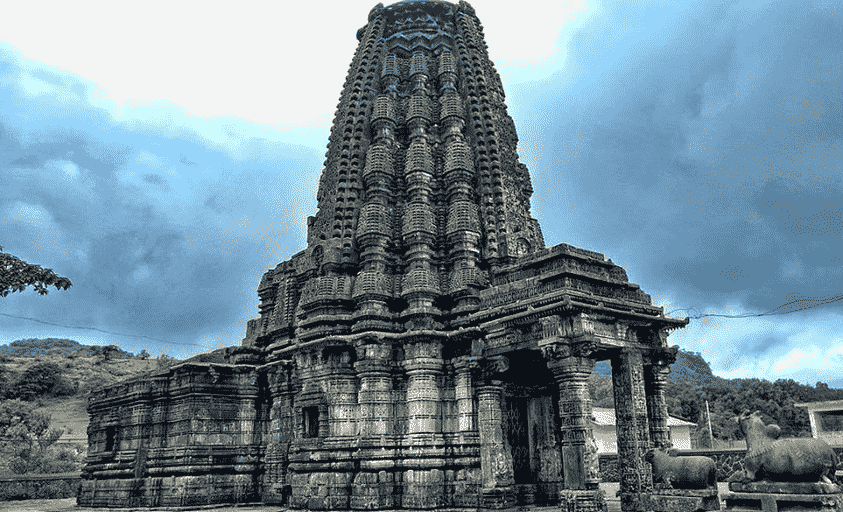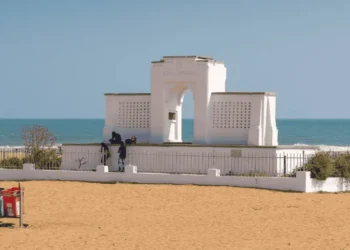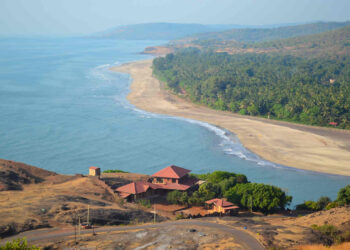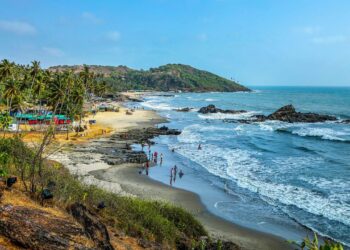Amruteshwar Temple in Ratanwadi, Ahmednagar district, dedicated to Lord Shiva, is one of twelve Shiva temples built by King Jhanjhaa as revered place of worship. Set on a rocky hill near the Pravara River, about 12 km from Bhandardara, its cave-like sanctum, stone carvings, and divine presence draw devotees and pilgrims from across India.
Mythological Importance
The Amruteshwar Temple carries old legends. One story tells of sage Agastya, who prayed on this hill, seeking Lord Shiva’s blessings for eternal life. Shiva appeared as a lingam, granting nectar-like water that flows around it, earning the name Amruteshwar, meaning “lord of nectar.” Another tale says the Pandavas, during their exile, worshipped here, carving the lingam in a single night. Local belief holds that the hill’s spring has holy power, offering health and peace. This makes the temple a key Shiva shrine, tied to divine immortality and grace.
Historical Overview
The temple began in the 9th century, under the Shilahara dynasty, though some say worship started earlier. Ratanwadi, 12 km from Bhandardara, was a sacred spot, as old texts show. A stone writing from 850 CE near the hill marks a holy lingam, but the temple grew with Shilahara kings. In the 11th century, Chalukya rulers added carvings, as etchings note. The 1600s saw no major damage due to its hidden spot, keeping it safe. In the 1700s, Maratha chiefs built paths, making it a pilgrimage place, Ahmednagar logs say. After 1947, Maharashtra’s leaders took over, and the Endowments Department now cares for it. From 2010 to 2015, repairs added steps while keeping the old sanctum. Marathi songs by saints like Eknath, who praised Shiva, spread its name.
Temple Structure and Design
The Amruteshwar Temple, covering 1 acre, combines Hemadpanthi and Shilahara styles, woven into the hill’s natural beauty. The low dome, restored in 1700, stands firm with stone carvings of Shiva with serpents, Ganesha with a trunk, and sages with beads, painted in white and gold. A carved door with leaf motifs leads to the cave-like sanctum, where the Shiva lingam, 2 feet tall, rests under a flat vimana, its plain roof showing grace. The sanctum’s rock walls, aged by time, show faint Shilahara etchings of Shiva’s battles, lit by mustard oil lamps. Small shrines for Parvati, Nandi, and Hanuman dot the hill, made of local granite with open stone roofs. The Parvati shrine, from 1000 CE, shows her with a lotus, granting love. The Nandi shrine, by the path, depicts a bull kneeling, calling for devotion. The Hanuman shrine, near the steps, shows him with a gada, carved in faith. These shrines, though simple, join the temple’s holy worship, offering paths to devotion. Set on a hill, the temple is reached by 80 stone steps from Ratanwadi village, worn by devotees’ feet. The steps pass caves with old Shiva carvings, some in rocks, others under the sky. The hilltop courtyard, paved with rough basalt, feels sacred, cooled by tamarind trees. A stone pool, fed by a hot spring, is for ritual dips, its rim etched with turtle shapes, a Shilahara mark. The temple’s low stone walls have niches for Garuda figures, said to guard the holy grounds. Carvings on pillars tell Shiva’s tales—his fight with Andhaka, his kind form, his tie to Parvati—etched to guide devotees. The 2010 repairs added sturdy paths but kept the hill’s raw, holy charm, making it a calm spot for prayer.
Rituals and Festivals
The temple holds festivals with full spirit. Mahashivratri, in February or March, is the grandest, honoring Shiva with Jal Abhishekam and lamp marches. Shravan Maas, in July or August, has Milk Abhishekam for cleansing. Kartik Purnima, in November, sees lamp-lighting by the spring. Daily worship includes Suprabhata Seva (morning prayers), Archana (offerings), and Sandhya Aarti (lamp ritual). Services like Rudra Homam and Spring Abhishekam can be booked at the temple office. A prasad stall gives free jaggery sweets to devotees. Bilva Archana, offering bilva leaves on Tuesdays, is for health and peace.
Information for Travelers
Hours and Entry: Open daily, 5:00 AM to 12:00 PM, then 3:00 PM to 9:00 PM. Entry is free, but rituals cost 100-500 rupees.
Clothing: Wear modest clothes covering shoulders and knees. Men doing rituals wear dhotis, often bare-chested, as custom.
How to Get There:
Air: Nashik’s Ozar Airport, 80 km away, is nearest. Taxis take 2 hours, costing 1500-2000 rupees.
Train: Igatpuri Railway Station, 50 km away, links to Mumbai (3 hours) and Nashik (1 hour). Autos to the temple cost 300-400 rupees.
Road: Ratanwadi is 12 km from Bhandardara. Buses from Bhandardara Bus Stand (30 minutes) stop at Ratanwadi village, 1 km away. Autos cost 20-40 rupees.
Places to Stay:
Ratanwadi has guesthouses like Village Homestay (500-1000 rupees). Bhandardara, 12 km away, has hotels like MTDC Resort (1500-3000 rupees). Stalls by the temple sell vada, dosa, and tea.
Best Time to Visit:
October to March has cool weather, 20-30°C. Weekdays are quiet. Mahashivratri brings crowds, so book early.
Nearby Attractions: Kalsubai Peak, 15 km away, is a trekking spot. Sandhan Valley, 20 km away, offers adventure. Ratangad Fort, 5 km away, is a historic site.
Final Thoughts
Maharashtra, a divine land of old tales in India, has many temples that blend faith and art. The Amruteshwar Temple in Ratanwadi is a jewel among them, set on its sacred hill. Its devotion to Shiva, fine Shilahara carvings, and role as a historic shrine make it a must-see among the state’s holy places.











